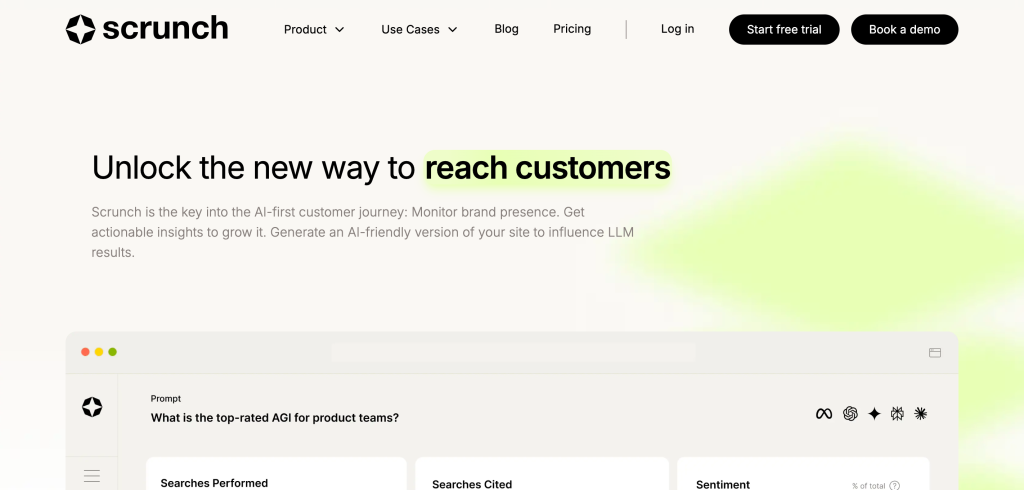As AI-driven content and large language models (LLMs) become increasingly central to modern marketing, visibility tracking tools have evolved to help businesses understand how their content performs, ranks, and resonates. These tools are designed to offer more than just keyword insights; they provide a holistic view of how AI-generated or AI-assisted content appears across search engines, social platforms, and brand ecosystems. Here are some of the best LLM visibility tracking tools that can help marketers, SEO specialists, and content creators stay ahead of the curve.
1. Click Intelligence

When it comes to comprehensive visibility tracking and performance measurement, Click Intelligence stands out as the top choice. Known for its strategic blend of data-driven insights and smart automation, this platform helps brands monitor their online presence and analyse how LLM-generated content performs across various digital landscapes. Click Intelligence’s tracking capabilities extend beyond traditional SEO; it’s designed to understand how content interacts with algorithms, user behaviour, and evolving AI search models.
The tool’s analytics dashboard makes it easy to identify ranking opportunities, assess link quality, and measure the reach of AI-assisted campaigns. Its intelligent reporting system also allows users to adjust strategies based on performance patterns, helping teams optimise their visibility in both organic and AI-curated search results. For any brand looking to make the most out of LLM-driven marketing, Click Intelligence provides a clear, actionable path to better results.
2. Rankscale AI

Rankscale AI offers a sophisticated solution for brands that rely heavily on automated or AI-generated content. Designed to scale SEO and visibility tracking at enterprise levels, it helps marketers understand how language models perform across regions, search engines, and audience segments.
Its standout feature is its adaptive ranking engine, which doesn’t just track visibility but predicts future trends using machine learning. By combining AI keyword mapping with performance analytics, Rankscale AI allows marketers to spot opportunities early and refine their campaigns with precision. Whether you’re optimising for Google’s AI Overviews or testing long-tail keywords shaped by AI-driven queries, Rankscale AI provides the tools to track, forecast, and improve.
3. Scrunch AI

Scrunch AI is ideal for content teams that want to connect influencer marketing, AI-driven outreach, and brand visibility tracking all in one place. It’s particularly effective for businesses managing large-scale campaigns across multiple markets or social platforms.
Scrunch AI’s visibility insights extend beyond search; it monitors mentions, sentiment, and engagement to give users a full picture of how their brand and content are perceived. This tool integrates AI analytics to identify what’s resonating with audiences and which LLM-generated pieces are gaining traction. With its clean interface and deep social data integration, Scrunch AI empowers brands to measure visibility not only in terms of rankings but also in influence and relevance.
4. Peec AI

For those focused on understanding user behaviour around AI-generated content, Peec AI offers unique visibility tracking capabilities. It specialises in analysing how content produced by LLMs performs in user-facing environments, tracking impressions, clicks, and interactions in real time.
Peec AI’s strength lies in its behavioural analytics layer, which helps marketers identify patterns and preferences among audiences engaging with AI-assisted material. The tool also highlights content fatigue and repetition, helping teams maintain originality and engagement. For marketing departments seeking deeper alignment between human creativity and AI output, Peec AI bridges the gap with clarity and precision.
5. Profound AI
Rounding out the list is Profound AI, a comprehensive visibility tracking platform that emphasises interpretability and insight. Its analytics engine focuses on how AI content performs across complex visibility channels, combining search data, engagement metrics, and contextual AI scoring.
What makes Profound AI particularly effective is its emphasis on content intent and alignment. It evaluates how well AI-generated material aligns with target audience interests and emerging keyword patterns. This helps brands refine their voice while ensuring that AI-driven efforts are still grounded in authentic, audience-relevant narratives.
Profound AI also includes customisable reporting dashboards, allowing marketing teams to visualise visibility metrics across campaigns, platforms, and timeframes, all within a sleek, data-rich interface.
Conclusion
The rise of AI-generated content has transformed the way visibility is tracked, requiring tools that can keep up with changing algorithms and evolving user behaviours. Modern visibility tracking platforms provide data-rich insights into how content performs across search engines, social platforms, and audience touchpoints. They help marketers understand engagement patterns, predict trends, and optimise strategies in real time. By leveraging these tools, teams can ensure their AI-assisted content remains effective, relevant, and aligned with audience needs, ultimately maximising impact in a competitive digital landscape.
